Chapter 26 : The Seed Plants: Gymnosperms & Angiosperms
1/29
There's no tags or description
Looks like no tags are added yet.
Name | Mastery | Learn | Test | Matching | Spaced |
|---|
No study sessions yet.
30 Terms
Describe the evolutionary history of seed plants for each era. How did the climate change throughout this?
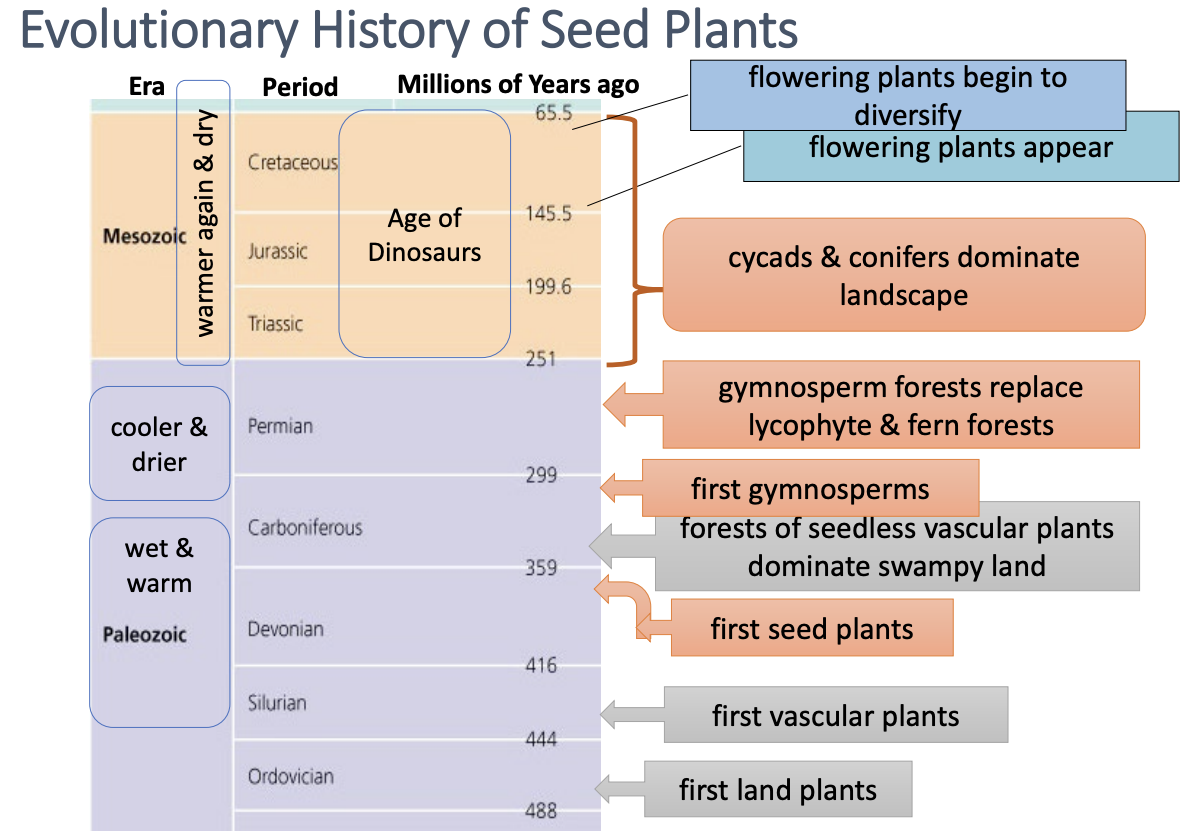
Describe the Female gametophyte in seed plants and its structure. What function to these structures serve?
The egg
Endosperm-producing cell (supports the growth of the embryo)
Embryo – produced from the diploid zygote, grows into the sporophyte when seed germinates
Seed - offers the embryo protection, nourishment, and a mechanism to maintain dormancy, allow plants to disperse the next generation through both space and time
Describe the Male gametophyte in seed plants
Pollen grains (contain the sperm of the plant)
Protected from dessication
Not dependent on water to reach the female organs
How do the Gametophyte and Sporophyte differ in mosses and other nonvascular plants compared to ferns and other seedless vascular plants?
Mosses and other nonvascular plants
Gametophyte: Dominant
Sporophyte: Reduced, dependent on gametophyte for nutrition
Ferns and other seedless vascular plants
Gametophyte: Reduces, independent (photosynthetic and free-living)
Sporophyte: Dominant
Describe the gametophyte and sporophyte of seed plants. What do they look like in Gymnosperms and Angiosperms?
Gametophyte: reduces( usually microscopic), dependent on surrounding sporophyte tissue for nutrition
Sporophyte: Dominant
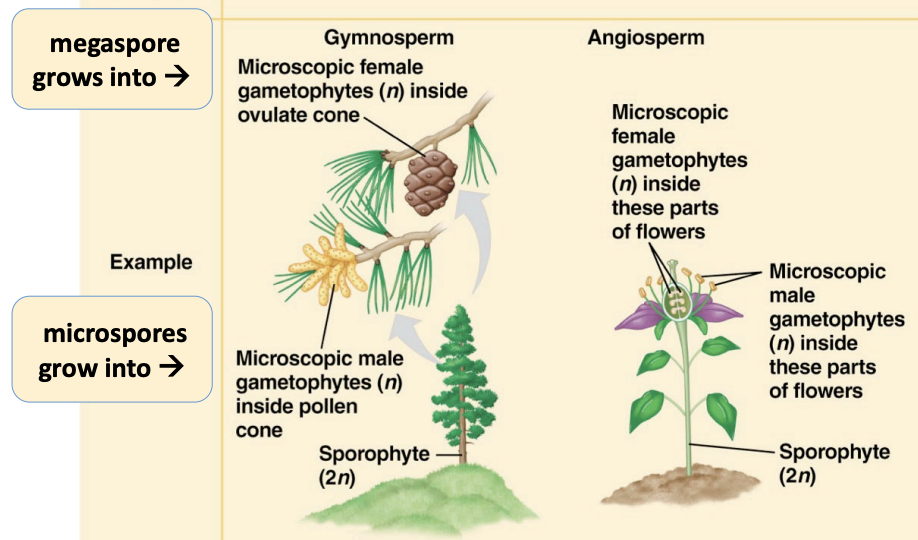
What does it mean for seed plants to be heterosporous? Describe heterosporous spore production.
Seed plants are heterosporous:
megaspores (grow into female gametophytes)
microspores (grow into male gametophytes)
Heterosporous spore production
Megasporangium in megasporophyll → Mgeaspore → Female gametophyte → Eggs
Microsporangium in microsporophyll → Microspore → Male gametophyte → Sperm
Where do both gametophytes mature and why?
Both gametophytes mature within sporangia
highly reduced in size
protected from drying & UV
What structures is the ovule composed of and how does the Megaspore eventually produce an egg?
Ovule = integument + megasporangium + megaspore
Megaspore germinates within ovule, develops into tiny female gametophyte – produces egg which will eventually be fertilized
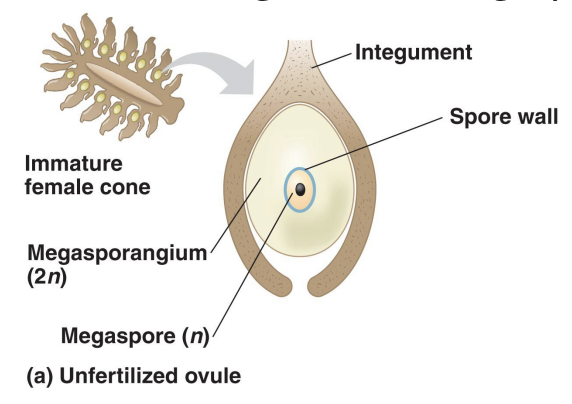
Where does the seed develop from. What is included in the seed?
Develops from fertilized ovule
includes: embryo, food supply, seed coat
What are pollen grains? What in the pollen wall protects the pollen grains?
Pollen grains: male gametophyte surrounded by pollen wall (partly secreted by sporophyte)
Capable of long dispersal, tough & resistant
Sporopollenin in the pollen wall protects pollen grains
True or false: The sperm nuclei in the pollen grain requires external H2O for fertilization.
FALSE. It does not require external H2O.
What are the 3 steps of fertilization in pollen grains? Define pollination.
Pollen grain germinates
Pollen tube
Sperm discharged into female gametophyte
Pollination: transfer of a pollen to a part of the seed plant that contains the ovule
Describe Gymnosperms: What do they look like, how do they pollinate, what does their life cycle look like, and what cell they have in their xylem
‘Naked’ seeds (partially sheltered by sporophylls)
Separate male and female gametes
Pollination by wind
Tracheids: long, tube-shaped cells in the xylem of vascular plants that transport water and minerals and provide structural support
Life cycle involves alternation of generations
Describe the gametophytes and sporophytes of Gymnosperms, heterosporous/homosporous, and their reproductive organs
Reduced male and female gametophytes
Dominant sporophyte
All are heterosporous
Male and female reproductive organs can form in cones or strobili
Monoecious (has both male and female reproductive organs on the same individual) or Dioecious(has male and female reproductive organs on separate individuals)
What is the life cycle of a Conifer? (gymnosperm)
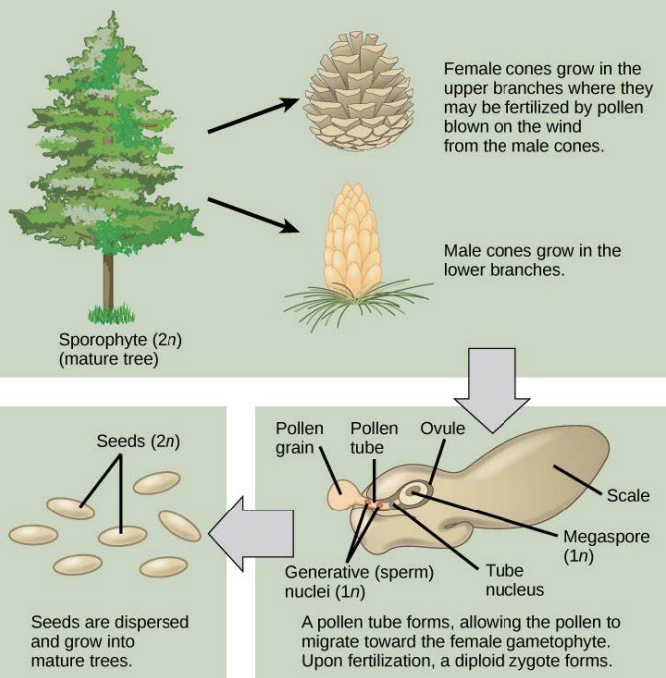
Describe differences between Gymnosperms and Angiosperms. Give 3 examples for Gymnosperms and 1 for Angiosperms.
Gymnosperms
Non flowering
naked seed
EX: Conifers, cycads, Ginkgos
Angiosperms
Flowering
Covered seed
EX: all flowering plants
What are the Five Phyla of Extant Seed Plants. Which ones are Gymnosperms and which ones are Angiosperms?
Gymnosperms:
Coniferophyta
Cycadophyta
Gnetophyta
Ginkophyta
Angiosperms:
Anthophyta
Describe the Phylum Coniferophyta: common name, female and male structures, environment, appearance, 4 examples
“conifers”
Most diverse gymnosperms today
“cone-bearers”
male pollen cone (sperm not motile)
female ovulate cone
dominate high altitudes & latitudes in N. Hemisphere
most are evergreen with needle-like leaves
EX: pine, fir, spruce, sequoias
Describe Phylum Cycadophyta (cycads): appearance, female and male structures, pollination method
fern-like or palm-like fronds radiate from central stem
central female & male cones
with flagellated sperm
beetles are involved in pollination of some cycads
Describe the Phylum Ginkgophyta - ginkgos: appearance, what are they used in, what structure does the sperm have, male and female structures, one example
unique fan-shaped leaf & veins
herbal medicine
with flagellated sperm
female sporophylls, not cones
male sporophylls, in strobili
one extant tree: Ginkgo biloba
Describe the Phylum Gnetophyta: gnetophytes: what are the 3 distinct genera, male and female structures, 1 example
3 distinct genera:
Gnetum in tropics
Welwitschia in SW Africa deserts
Ephedra in U.S. deserts
male & female strobili; sperm not motile
Ephedra - herbal medicine (Ephedrine)
What are the two key innovations of Angiosperms?
flowers & fruits
What is the purpose of the flower in Angiosperms? Why is it a successful innovation? Define each structure in the flower: sepals, petals, stamen, filament, anther, carpel, stigma, style, ovary, ovules
Sepals – green leaf-like appendages that enclose the rest of the flower
Petals – brightly colored appendages that aid in attracting pollinators
Stamen:
Filament – stalk that holds up pollen-producing sac
Anther – terminal sac that produces pollen
Carpel (aka “pistil”):
Stigma – sticky tip of carpel that receives pollen
Style – long tube leading from stigma to ovary
Ovary – structure at base of the carpel that produces ovules
Ovules - develop into seeds if fertilized
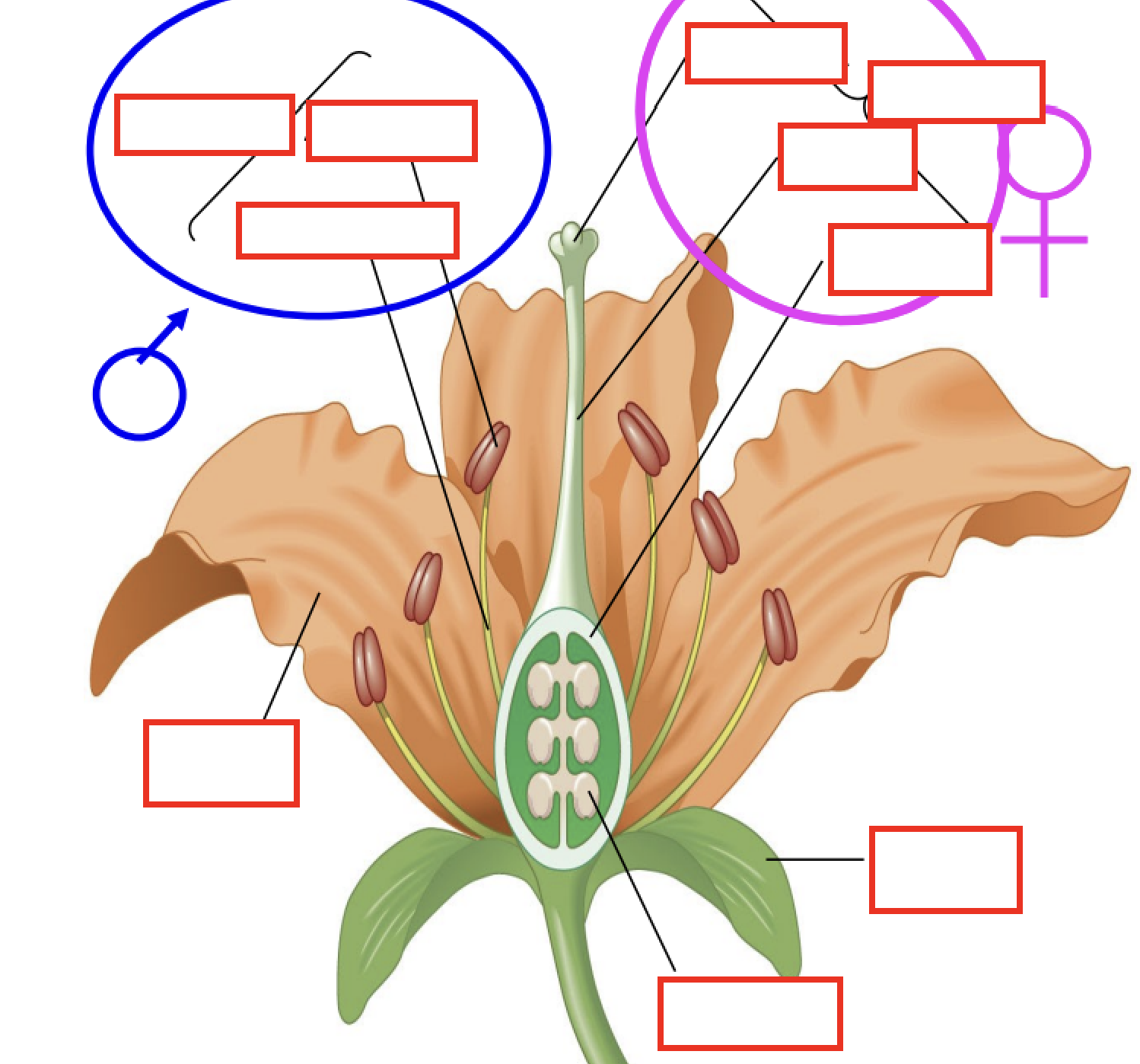
Fill in the blank
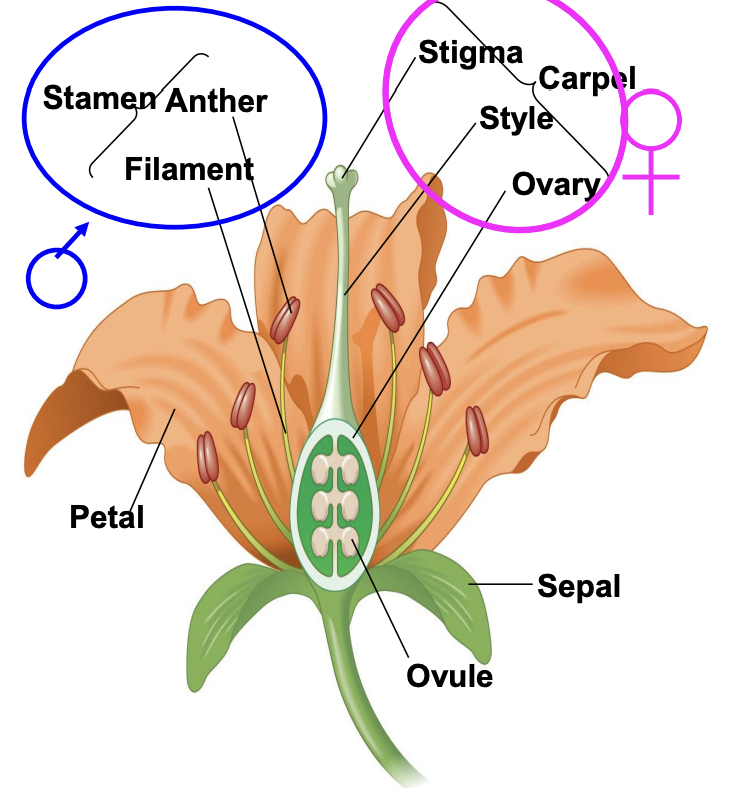
Describe the Life cycle of Angiosperms: from Microsporangia to Pollen grains, From Ovule to 2 polar nuclei
Microsporangia → Male sporocytes (2n) -(meiosis)→ Microspores (n) -(mitosis)→ Pollen grains
Pollen grains: 1 generative cell, 1 tube cell
Ovule → Megasporangium → Megasporocyte (2n) -(meiosis)→ 4 Megaspores (n) → Only large megaspore survives -(mitosis x3)→ 8 nuclei distributed among 7 cells of female gametophyte → 3 cells at one pole become egg and 2 synergids (remaining 3 cells become antipodal cells) → Center cell → 2 polar nuclei
How does double fertilization happen in angiosperms?
double fertilization with 2 sperm nuclei:
one fuses with egg, forming zygote(2n)
one fuses with 2* central nuclei (polar nuclei), forming endosperm (3n*) food supply in seed
What is a fruit and what is its purpose in Angiosperms? Give 5 examples.
Fruit - mature ovary of a flower, thickens around seeds
may include some additional tissues as well
may be fleshy or dry
protects seeds
main function is enhancing seed dispersal
EX: Tomato, Ruby grapefruit, Nectarine, Milkweed, Hazelnut
What are the two big groups of angiosperms? What are some examples from each group?
The 2 big groups of angiosperms are the Monocots (~60,000 spp.) & the Eudicots ( ~ 175,000 spp.)
Monocots include orchids, palms, lilies, grasses…
Dicots include… lots! (oaks, peas, roses, potatoes, etc.)
Describe the differences between Monocots and Eudicots in the following structures: tissue, embryos, leaf venation, stems, roots, pollen, flowers
Tissue
Monocots: True woody tissue is rarely found
Eudicots: can be herbaceous (non woody) or produce woody tissues – tough walled xylem cells
Embryos
Monocot: One cotyledon
Eudicot: Two cotyledons
Leaf venation
Monocot: Veins usually parallel
Eudicot: Veins usually netlike
Stems
Monocot: Vascular tissue scattered
Eudicot: Vascular tissue usually arranged in a ring
Roots
Monocot: Root system usually fibrous (no main root)
Eudicot: Taproot (main root) usually present
Pollen
Monocot: Pollen grain with one opening
Eudicot: Pollen grain with three openings
Flowers
Monocot: Floral organs usually in multiples of three
Eudicot: Floral organs usually in multiples of four or five
How do humans use seed plants?
Almost all food & beverages & spices
(80% calories globally!)
Wood products, including paper
Fuel
Fiber for clothing, rope
cotton, linen, jute, hemp
Secondary compounds:
countless drugs & medicines
In the United States, about 25% of prescription drugs contain an active ingredient from plants
perfumes
latex rubber
Ornamental plants